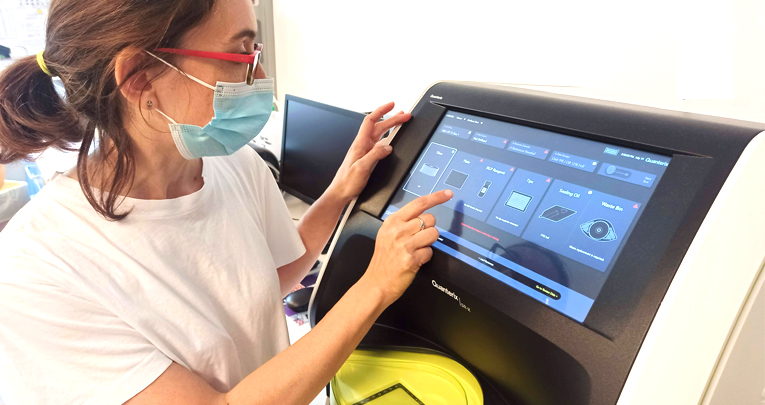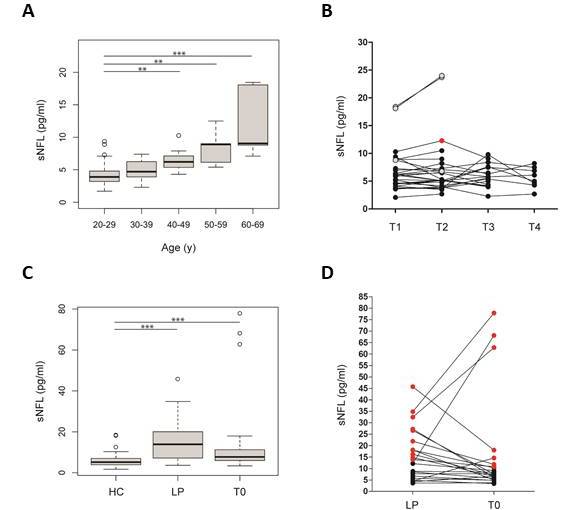
Multiple Sclerosis and Related Disorders
, September 2021
Serum neurofilament light chain levels in healthy individuals:
A proposal of cut-off values for use in multiple sclerosis clinical practice
Paola Valentino 1 , Fabiana Marnetto 2 , Serena Martire 3 , Simona Malucchi 4 , Cecilia Irene Bava 3 , Maja Popovic 5 , Antonio Bertolotto 4
Abstract
Background
Serum Neurofilament Light (sNFL) is the most promising marker for patient's monitoring in Multiple Sclerosis (MS). However, operating reference values for use in clinical practice are still lacking. Here, we defined sNFL reference cut-off values in a cohort of healthy controls (HC) and assessed their performance in Multiple Sclerosis (MS) patients, as well as the intra-individual sNFL variability.
Methods
We measured sNFL by single molecule array (Simoa) assay in 79 HC assessing their correlation with age. Changes of sNFL levels were evaluated during a short-term follow-up (median 67 days between consecutive samples) in a subgroup of 27 participants. sNFL were tested in 23 untreated MS patients, at both diagnostic time and start of therapy (median 80 days after), considering disease activity.
Results
Findings confirmed a correlation between sNFL levels and age in HC, thus cut-off values specific for age decades were calculated. sNFL did not vary significantly with time during short-term follow-up (median CV 13%). sNFL levels in MS patients were higher and demonstrated a higher variability between diagnostic time and treatment start (median CV 39%). According to cut-off values, "pathologic" sNFL levels were found in 57% of MS patients at diagnostic time, and in 30% of samples at treatment start. In particular, "pathologic" sNFL levels were found in 80% of samples (16/20) obtained during a phase of disease activity, while a total of 85% of samples (22/26) associated with inactive disease showed sNFL in the normal range.
Conclusion: This study demonstrates an overall intra-individual stability of sNFL values in the short-term in HC and suggests age-dependent reference cut-off values that could be beneficial for sNFL implementation in clinical practice.
Keywords: Biomarker; Multiple sclerosis; NFL; Neurofilament light chain; Reference values; Serum; Variability.
Panel A
shows NFL levels in healthy controls stratified according to age-decade, based on which we calculated cut-off values to discriminate pathological and physiological NFL levels.
Panel B
shows the intra-individual variability over time of NFL levels in healthy controls.
Panel C
compares NFL levels in healthy controls (HC) and in MS patients at diagnostic lumbar puncture (LP) and before treatment start (T0).
Panel D
shows the variability of NFL levels in MS patients between LP and T0, and highlights in red the pathological levels according to the age-decade cut-off values previously defined.
1
Clinical Neurobiology Unit, Neuroscience Institute Cavalieri Ottolenghi (NICO), Regione Gonzole 10, Orbassano 10043, Italy; Department of Neuroscience "Rita Levi Montalcini", University of Turin, Via Cherasco 15, Turin 10100, Italy.
2
Clinical Neurobiology Unit, Neuroscience Institute Cavalieri Ottolenghi (NICO), Regione Gonzole 10, Orbassano 10043, Italy; Department of Neuroscience "Rita Levi Montalcini", University of Turin, Via Cherasco 15, Turin 10100, Italy.
3
Clinical Neurobiology Unit, Neuroscience Institute Cavalieri Ottolenghi (NICO), Regione Gonzole 10, Orbassano 10043, Italy.
4
SCDO Neurologia and CRESM, University Hospital AOU San Luigi Gonzaga, Regione Gonzole 10, Orbassano 10043, Italy.
5
Cancer Epidemiology Unit, Department of Medical Sciences, University of Turin, Via Santena 7, Turin 10126, Italy.









